Learn how to make Fermented Hot Sauce – a simple way to enhance and preserve your abundance of garden chilies to use throughout the winter. Full of healthy probiotics, this easy recipe has many health benefits. Plus it just tastes good! Video.
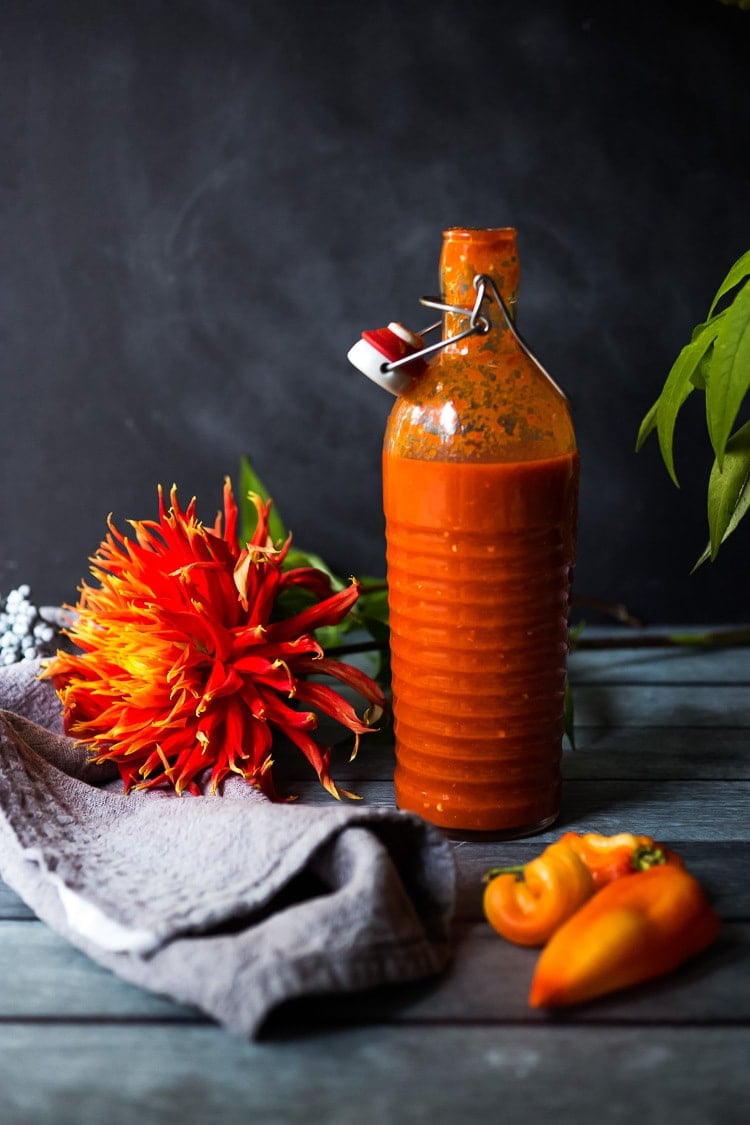
For many of you with gardens out there, this is the season of harvesting. Here’s a simple way to use all those chilies you’ve got growing out back and turn them into something that will bring you a little kiss of sunshine during the cold months – Fermented Hot Sauce! Now, before you feel intimidated – know that this only takes 20 minutes of actual hands-on time and no special equipment. It’s ridiculously easy!
Why I prefer fermenting over canning:
- Healthier: Fermentation creates “ALIVE” food- incredibly rich in probiotics. These good bacteria are living creatures that work with our microbiome to improve digestion, boost immunity, and prevent disease. Having a diverse microbiome is healthy! Canning “kills” all these healthy probiotics through the heating process.
- Taste: I prefer fermentation over “canning” because fermentation keeps these healthy bacteria alive, and as a result, the fermented food actually tastes better and better with time! Canning halts the development of flavor.
- It’s easier: Canning requires more hands-on time.
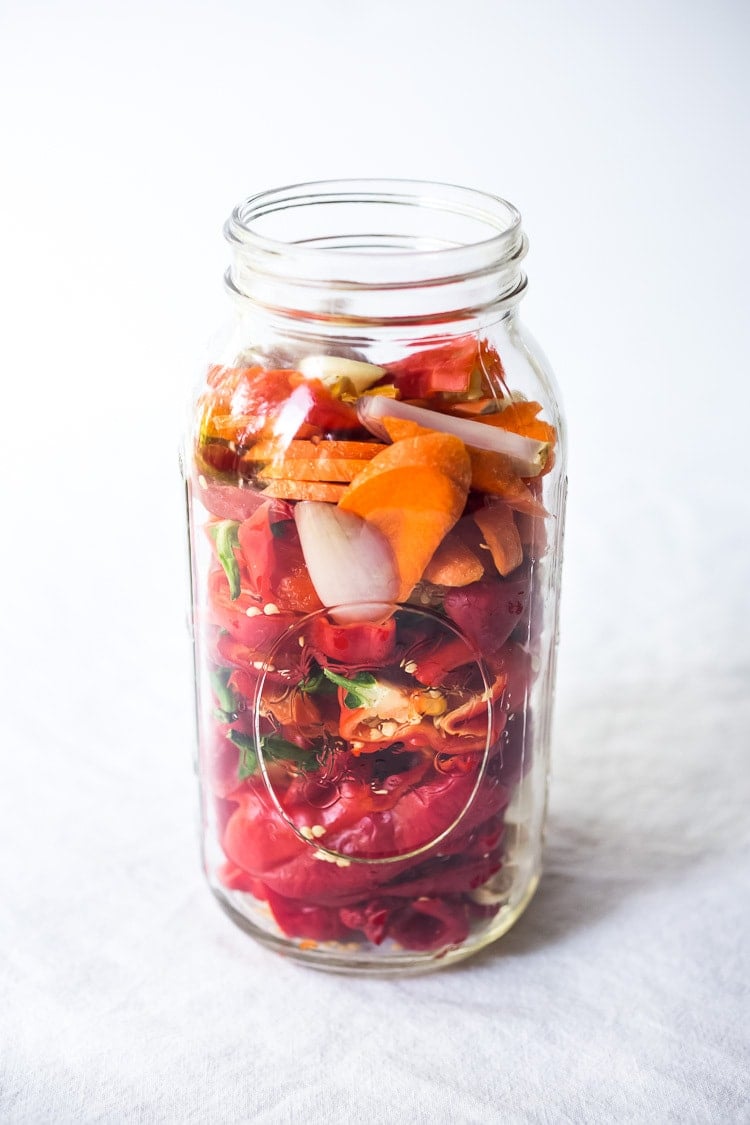
How to make Fermented Hot Sauce:
Step one: Fill a clean 2-quart jar with any type of fresh hot chili, onions, garlic and thinly sliced carrot. You can use bell peppers to temper the hot chilis if you want a milder version. Just stick with the same color palette so your fermented hot sauce stays colorful and vibrant.
In this recipe, I used Padrone Peppers, a Spanish variety that had turned red, which I found at our farmer’s market. But feel free to use any kind you want or a blend. You’ll need about 1 pound in total. (You can easily halve this recipe)
Step two: Make a saltwater brine, using 1 1/4 teaspoons fine sea salt, per 1cup of water.
Salt Ratio for Fermentation:
Having the right proportion of salt to water is important. Not enough salt may allow unhealthy bacteria to grow. Too much salt will kill all the bacteria and the chilies won’t ferment. If you need to add more water to the jar, then add salt accordingly.
Use 1 1/4 teaspoons fine sea salt per 1 cup of water. This is roughly a 3% Brine (3 grams of salt per 100g of water).
Here, I used 5 cups of water, so I added 1 1/4 teaspoon salt x 5 cups water = roughly 6 1/4 teaspoons of fine ground sea salt. Heating the water slightly helps the salt dissolve.
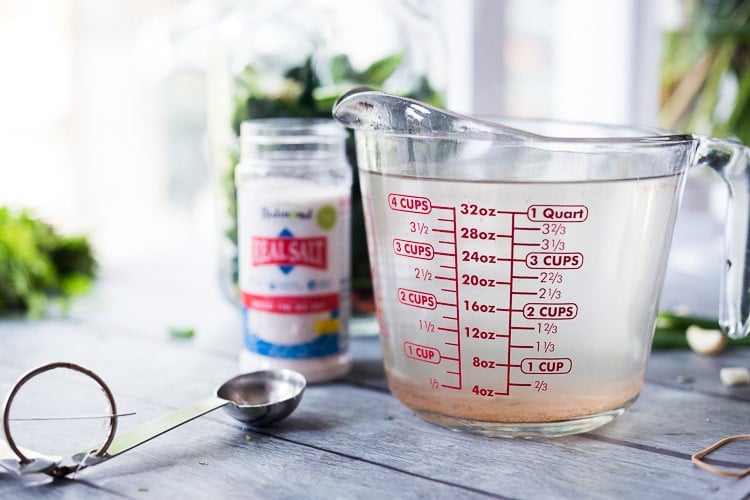
Step Three: Combine! Pour the brine over the chilies and push them down so they are completely submerged under the brine. Feel free to cover the chilies with a cabbage leaf to keep everything down, then weigh them down.
Step Four: Weigh down the chilies. You can use a fermentation weight, like this version that I really like, that will fit perfectly into a mason jar, to keep everything submerged. If anything floats to the top, and touches air, this can potentially mold, so either fish it out with a slotted spoon, or push it down under the brine.
Or in a pinch, a zip lock bag filled with water can be used as a weight, just place this over top. I prefer using a glass or ceramic weight.
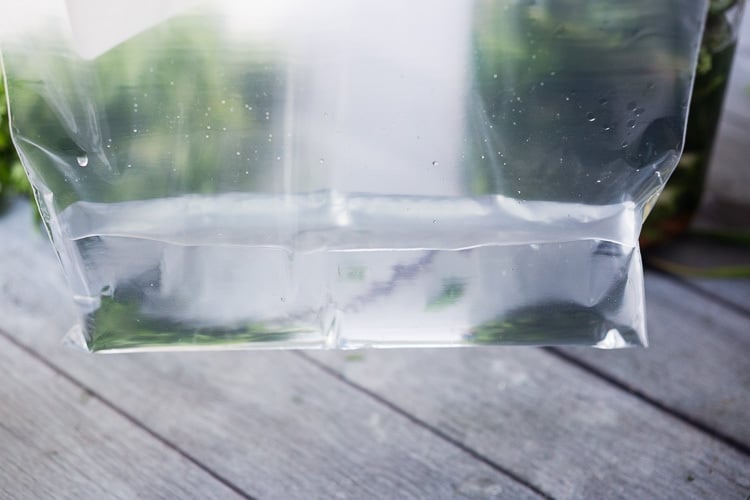
The water in the bag will work as the fermentation weight here. A small clean shot glass, placed over a cabbage leaf, can also act as a fermentation weight as well.
Here you can see I’m working on a mild green hot sauce which is in the fermenting phase still.
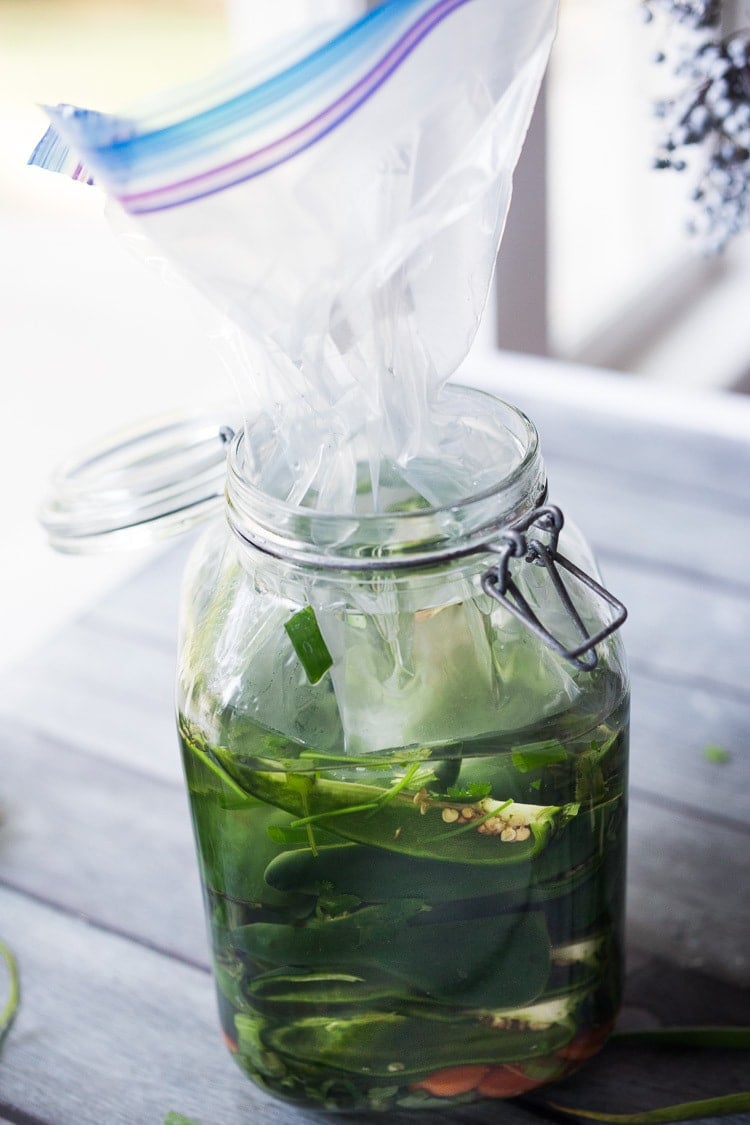
Step Five: Place a lid on top, leaving it loose. You want the fermentation gasses to be able to escape while keeping any creatures (bugs, flies) out. A couple of layers of cheesecloth also work here.
Step Six: Place the jar in a bowl or pan to catch any liquid that may spill over, and place it in a cool, dark place, like a basement. 65F-70F is ideal. If you don’t have a basement or a cool place, a lower cupboard in the kitchen is an option.
Check every few days, removing any “floaters”. After a few days, the brine will turn slightly cloudy, and when you tap the jar, you should see little bubbles float to the surface or some overflow on the pan- all signs of life!
Ferment 5-10 days. I usually go 7-12 days, long enough to soften those carrots, which you will be blending up in the sauce.
If, for some reason, you are going out of town, you can always place the ferment in your fridge, which will slow it down, but keep it alive, and you can resume when you get back.
Why is the Brine Cloudy?
Cloudy, tangy brine is a natural by-product of the fermentation process- a combination of lactic acid and yeast- and is the reason why they call it Lacto-fermentation.
Various strains of bacteria are present on the surface of all plants, especially ones growing close to the ground. Lactobacillus bacteria convert sugar into lactic acid, preserving the peppers.
Both salt and lactic acid prevent the growth of harmful bacteria. Over time, the cloudiness can settle out of the brine to the bottom of the jar. Some batches are naturally cloudier than others, but all are safe to consume.
A cloudy brine is a sign that you have a safe, successful, and tasty ferment.
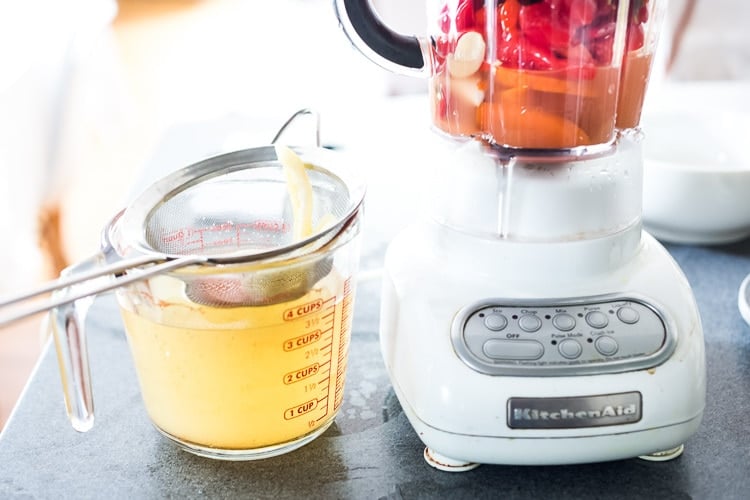
Step 7: Blend! Strain the brine, saving it. Add the strained chilies/carrots/garlic to the blender with one cup of brine and blend until smooth, a least a minute! At this point, you can add herbs (oregano or cilantro is nice here) and spices (cumin, coriander, chipotle). Add a little splash of Braggs apple cider vinegar if you like (this is optional but also full of healthy bacteria) and more brine to desired consistency.
If you like the idea Sriracha, you could also make it sweet by adding sugar or honey, and perhaps ginger. You could also add herbs.
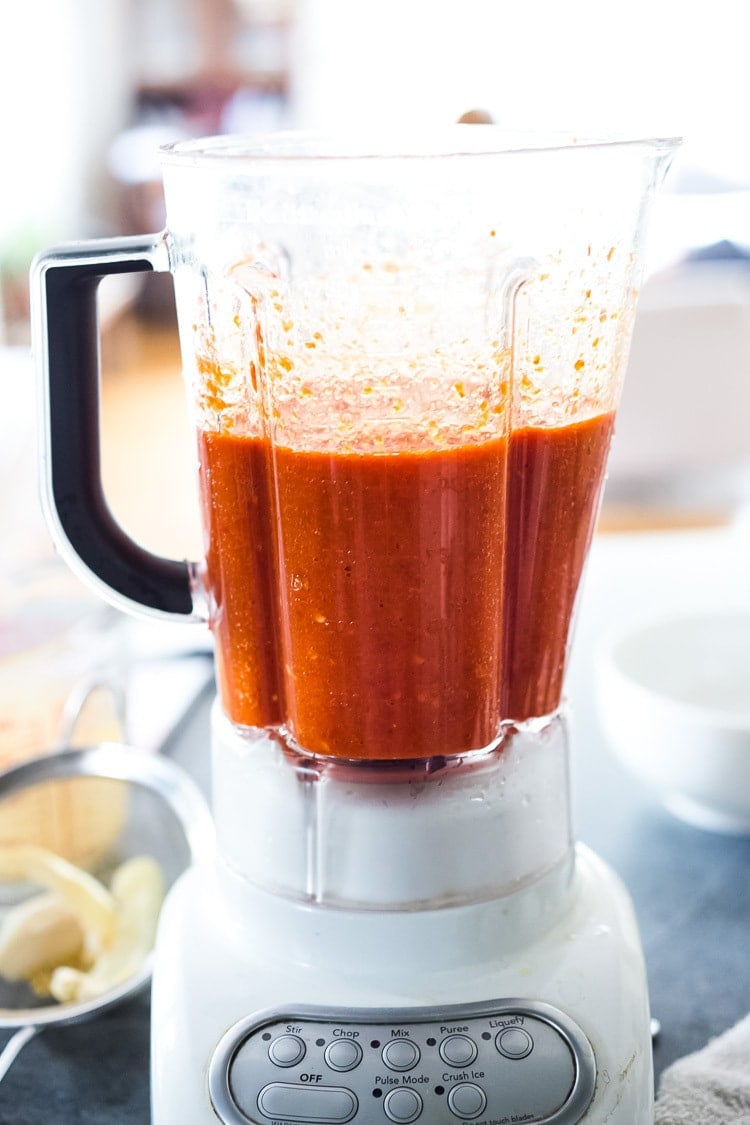
Step 8: Store! For everyday use, store the fermented hot sauce in squeeze bottles– leaving the tip off or open (or lightly closed) in the fridge. The hot sauce will continue to ferment in the fridge, and the open tip will allow the gasses out. Before using, cover the tip with your finger and give it a good shake.
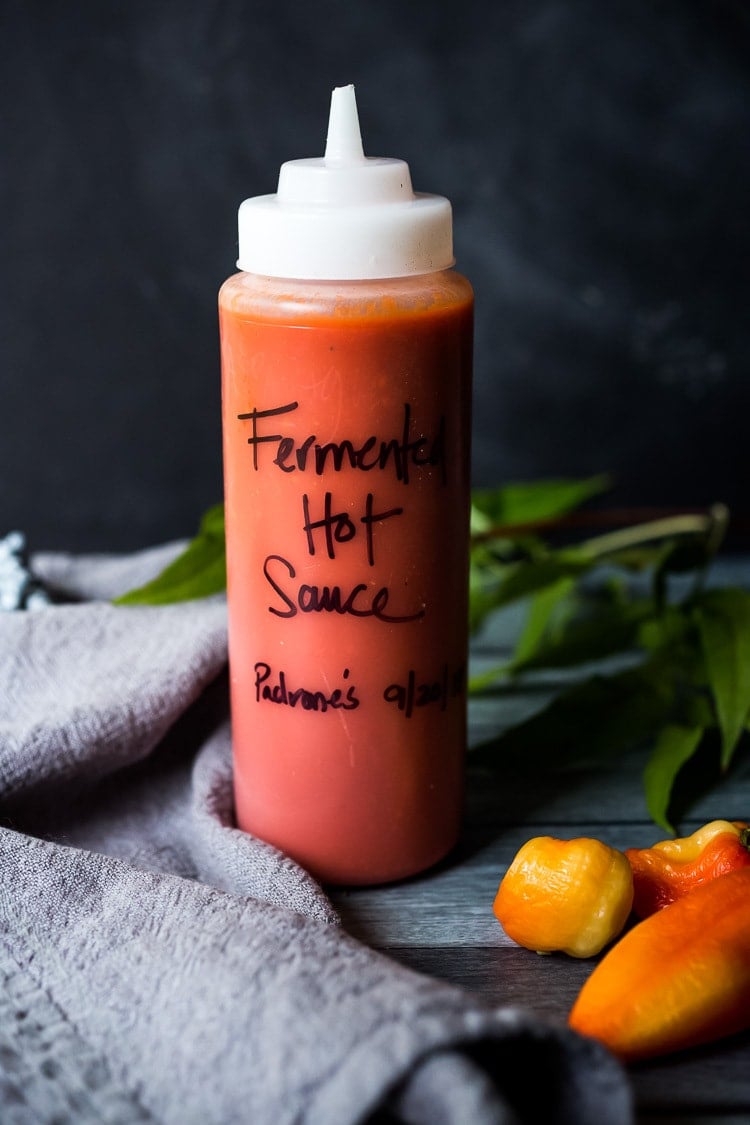
A little Warning!
If you place the fermented hot sauce in tightly sealed bottles, unrefrigerated, they will EXPLODE! This is because the hot sauce is still fermenting (producing gases) and will continue to create bubbles. Remember, it is alive, and this is NOT canning.
*If giving as a gift, yes, feel free to use a “cute bottle” but with instructions to refrigerate and loosen the lid.
But my hot sauce is way too hot!
Don’t be too alarmed if your hot sauce tastes overly hot when you first store it. After a week or two in the fridge, the gradual slow fermenting will substantially mellow out the heat! It’s quite surprising. Many times, I’ve made a hot sauce and tried it, thinking there was no way we would be able to eat it because of the heat level. But after a week or two, it really does calm down the heat. Fermenting the hot sauce gives it another layer of flavor, adding more and more complexity. This will keep indefinitely in the fridge.
Types of chilies to use:
Use any fresh chili pepper you like or a blend of different peppers (in the same color palate). To temper the heat, feel free to add similarly colored bell peppers (red, yellow, or green bell pepper). For example- add a golden bell pepper to habaneros to temper the heat. Or a green bellpeper to serano chilies.
Keep in mind you will be blending the sauce, so stick with the same color palate to make a vibrant-colored sauce. For example, mixing red and green peppers will yield a brown hot sauce- not the prettiest, but up to you. 😉
Also, keep in mind that fermentation will mellow out the heat of the peppers over time.
I am hearing that frozen peppers can be fermented ( please read the comments), but have not personally tried this.
Helpful tools
- Fermentation Kit (optional)
- Fermentation weights
- 2-quart mason jar (8-cup mason jar)
- Blender
- Strainer
- squeeze bottles
Making Fermented Hot sauce is a fun little project that only takes about 20 minutes of hands-on time. A lovely way to use up all the chilis in your garden (or a way to try out all the beautiful varieties at the farmers market) and a healthy way to bring more healthy probiotics into your life!
Mother Nature will do all the work for you! And after 5-7 days, you will end up with the most delicious, alive hot sauce that will get better and better with age!
Troubleshooting
- If there are no signs of fermentation, double-check you measured the salt ratio correctly. This is typically the most common problem (adding too much salt will halt the process and kill all the bacteria, even the good ones.).
- Try filtered water. Chlorinated water can halt fermentation.
- Do not over-wash or peel the peppers/carrots (for example, don’t use any type of produce soap) as the wild bacteria from the pepper skin, carrot peeling is what is starting the fermentation. I have the best luck with farmers’ market chili peppers and carrots because they are not over-cleaned or treated with anything.
- Mold: If your ferment has molded, something likely rose to the top of the jar and had contact with air. I would start over.
- Bad smell: the brine should smell tangy, garlic, and fresh, not “foul” in any way! If it smells “off,” it could be that salt was mismeasured or the ferment was contaminated: dirty hands, dirty utensils, dirty jar.
More Favorite Recipes!
- Yum Yum Sauce
- How to Make Kimchi!
- Simple Cabbage Sauerkraut
- Beet and Cabbage Sauerkraut
- Probiotic Gut Shot
- Curtido & Cultured Salvadoran Slaw
- How to make Fermented Pickles!
More from Feasting At Home
Watch HoW to make Fermented Hot Sauce!
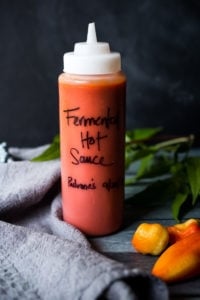
Fermented Hot Sauce
- Prep Time: 20 minutes
- Cook Time: 5 days
- Total Time: 120 hours 20 minutes
- Yield: 4 cups
- Category: Sauces, fermenting, preserving
- Method: fermenting
- Cuisine: American
- Diet: Vegan
Description
A simple, delicious recipe for Fermented Hot Sauce using fresh summer chilies, with no special equipment and only 20 minutes of hands-on time!
Ingredients
Saltwater Brine: ( 1 1/4 teaspoon salt per 1 cup of warm water) This is roughly a 3% Brine. (3 grams of salt per 100g of water)
- 5 cups filtered water
- 6 1/4 teaspoons finely ground sea salt (or Pink Himalayan salt) – use 1 1/4 teaspoon salt, per 1 cup of water.
- 2 Quart Mason Jar
Fillings:
- 16 ounces fresh chili peppers, sliced in half (about 6-7 cups) seeds & stem removed, see notes
- 1 carrot, very thinly sliced 1/16th-inch (do not peel!)
- 4–8 garlic cloves, cut into quarters
- 1–2 shallots, sliced (or 1/2 an onion)
After fermenting, add optional seasonings to taste. Keep in mind the “heat” will mellow with age.
- optional: herbs (oregano, cilantro, celery leaves) and spices (cumin, coriander, chipotle powder, smoked paprika)
- 1–3 tablespoons apple cider vinegar, (optional- for extra tang and for more healthy probiotics)
- honey or sugar to taste (optional, good if making Sriracha style)
- If your hot sauce is not hot enough, you can always add cayenne or ground chipotle to taste. Free free to add spices ( 1/2- 1 teaspoon) cumin, coriander, chipotle, allspice, etc. Make this your own.
Instructions
- Wash your hands, jar and ustensils. Not sterilized, just clean. 🙂
- Stir sea salt into the water until dissolved.
- Slice the small hot peppers in half, and remove stems and seeds if you like (for less heat). If your pepper are very hot, wear gloves. If adding bell peppers to temper the heat, cut into thin strips. Thinly slice the carrot (do not peel), slice the shallots, and slice the garlic.
- Layer all into a clean 2-quart mason jar. Top with a cabbage leaf to hold things down (optional) and pour the brine into the jar over the chilies, pressing them down under the liquid. If you need to add more brine, remember to use the ratio of 1 1/4 teaspoon salt per 1 cup of water.
- Weigh everything down with a fermentation weight (or use a small ziplock bag filled with water to weigh the veggies down or try a clean shot glass). You want the chilies completely submerged under the brine. Anything that touches air, may mold, so either spoon it out or push it down. Cover loosely with a lid ( or cheesecloth and rubber band) and place the jar in a pan or bowl to collect any liquid that may bubble over. The lid is loose here so gasses can escape easily, but no creatures can get in.)
- Place in a cool dark place, like the basement, 65-70F is ideal, (or the bottom cupboard in the kitchen) for 5-10 days or until signs of fermentation.
- On day 3-5: Check for fermentation: Tap the container and see if any tiny bubbles rise to the surface, check for a cloudy brine ( see notes) or check the bowl underneath, to see if there was any overflow. All signs of activity! Ferment 7-10 days, long enough to soften those carrots that you will be blending. And you can always ferment longer for even more flavor- I’ll often ferment 12 -14 days. Sometimes I’ll ferment 7 days, then place the jar in the fridge for a few weeks before blending. The longer the ferment, the tangier and more flavorful this will become, and the more mellow the heat. *If there are no signs of fermentation, give it a couple more days- then check the troubleshooting section in the post.
- After 7 days and signs of fermentation, strain and SAVE the brine. Place the fermented peppers, onions, garlic, and carrots into a blender and discard the cabbage leaf. Add 1 cup of the brine and blend until smooth as possible. This may take a couple of minutes. Add the vinegar if using, (and honey if you prefer a sweeter hot sauce like Sriracha), and more brine to desired thickness. At this point, you can blend in optional spices and herbs. ( 1/2-1 teaspoon spices, 1-2 tablespoons fresh herbs).
- Don’t be alarmed if it is overly spicy- the heat level will significantly mellow with time, as it continues to ferment in the fridge after 1-2 weeks. Place in a squeeze bottle and store in the fridge, leaving the tip open (or loose) for gasses to escape.
- Do not place in a sealed jar unrefrigerated– this will result in an explosion– and a great big mess- as the hot sauce is still alive and fermenting! BE WARNED! I have the best luck with using in squeeze bottles and leaving the cap off in the fridge.
- If transporting to a friend as a gift, it is ok to seal for short periods of time (a few hours) but make sure to tell them to refrigerate it and loosen the lid, very soon after receiving.
- The flavors will continue to develop and get more complex over time, the heat mellowing.
- To use, cover the tip of the opening with your finger and give a shake before using.
- This will keep up to 12 months in the fridge (probably even longer!).
Notes
WATER: Regular tap water may contain too much chlorine in it, inhibiting the fermentation process (although our tap water works fine). If fermentation is not happening, you may want to try filtered water.
SALT: I use fine ground sea salt or Pink Himalayan salt . If using coarse ground salt you may need to add a pinch more.
Peppers: Use any chili pepper you like or a blend of different peppers (in the same color palate). To temper, the heat, feel free to add similar colored bell pepper -substitute sweet red, yellow, or green bell pepper. Keep in mind, you will be blending the sauce, so stick with the same color scheme to make a vibrant colored sauce. For example, mixing red and green peppers will result in a brown hot sauce– but up to you. 😉 Also, keep in mind, the fermentation will mellow the heat a little. Removing the seeds will help temper the heat.
RATIO: If you need more water to cover or fill the jar, use 1 1/4 teaspoon salt per cup of warm water.
You could easily halve this recipe or use two, quart-sized jars.
CLOUDY BRINE: A cloudy brine is a natural by-product of the fermentation process-a combination of lactic acid and yeast and is the reason why they call it Lacto-fermentation. It is a sign of fermentation. Various strains of bacteria are present on the surface of all plants, especially ones growing close to the ground. Lactobacillus bacteria convert sugar into lactic acid, preserving the peppers.Lactic acid prevents the growth of harmful bacteria. Over time the cloudiness can settle out of the brine to the bottom of the jar. Some batches are naturally cloudier than others, but all are safe to consume and taste delicious. A cloudy brine is a sign that you have a safe and successful ferment.
Signs of fermentation: liquid overflowing into the bowl (check the bowl to see if the jar overflowed, a good sign! Tiny bubbles rising to the top when you tap the jar. Cloudy brine, tangy flavor or smell.
Nutrition
- Serving Size: 1 tablespoon
- Calories: 4
- Sugar: 0.4 g
- Sodium: 112.3 mg
- Fat: 0 g
- Saturated Fat: 0 g
- Carbohydrates: 0.9 g
- Fiber: 0.2 g
- Protein: 0.1 g
- Cholesterol: 0 mg
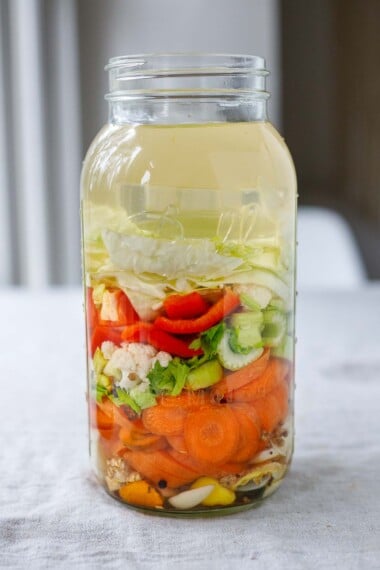
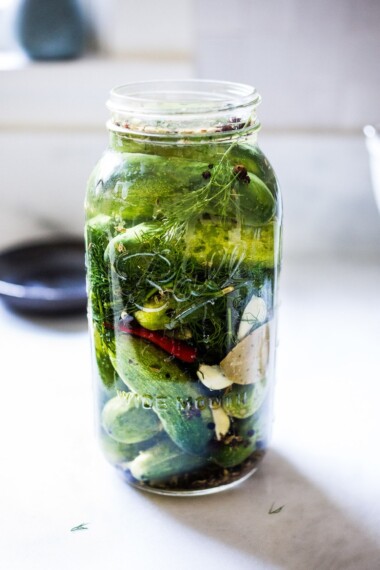
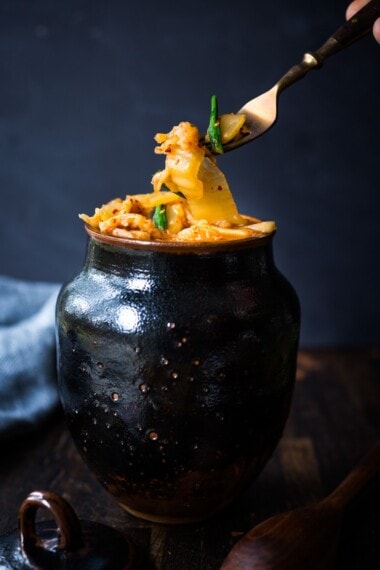
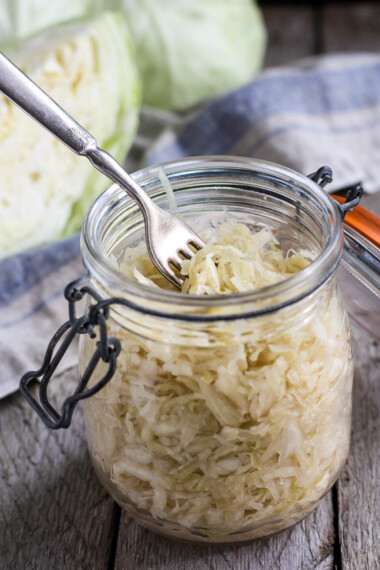


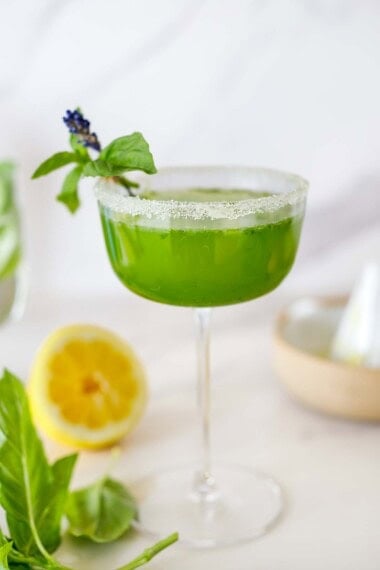
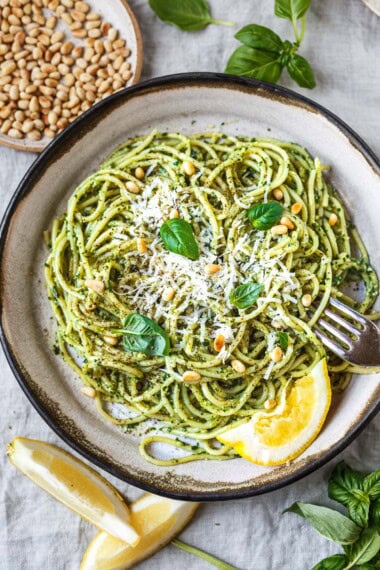

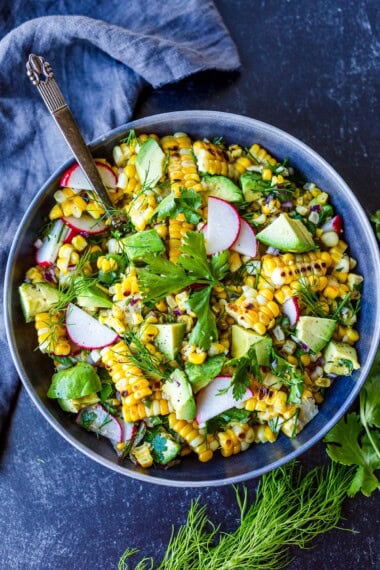
I wanna make my husband some hot sauce for Christmas this year. Thinking mango or pineapple habanero. Could I ferment the fruit too? Or do I need to add it later? If I don’t ferment the fruit, will that affect the longevity of the sauce?
I would ferment it too!
I had aphids over my peppers when I harvested them and washed them with soap to rid the pests. Will this cause an issue with fermenting or will the unpeeled carrots provide enough bacteria for the process to happen?
Thanks
It might! Give it a try!
I made three hot sauces using peppers gleaned from a farm before a hard frost. So good!
Question though: I have this wonderful spicy brine left over. Could I use that brine for other things? Specifically I have a ton of tiny gherkin cucumbers. Could I pickle them using this leftover brine?
You could try!? I like adding the brine to soups too!
Bummer! I went went to open my pepper mixture today and there was mold growing on the water filled bag that is there to keep the veggies under the brine😭 Any thoughts on why that happened? I assume I have to throw it all out because it was right at the water line .
Thanks,
Crystal
Hi Crystal- if you can get the mold off, it is honestly probably fine. It should be just at the top where veggies would have contact with air?
Good recipe. thanks for sharing. I did try it and was successful with the cloudy and bubbles! I had a couple of squeeze bottles on hand to store that sauce, so it worked well. I used a mix of peppers, and some were habaneros, so it is hot! But you are correct, really nice flavor.
Can I make this with dried peppers? I buy bags at a little mercado because I make my own recipe chili powder in order to have a more balanced flavor, instead of just heat.
I have not tried with dried peppers- but it is a great idea. I might give it a go just to see.
Thank you
Oh my, after 7 days of fermenting I blended my peppers, looks beautiful but it is way too hot!
What can I add to temper the heat…
How about tomato paste or tomato puree?
Can you reuse the brine to jump start the next fermentation?
There are mixed opinions on this. Feel free to give it a try- I haven’t had good luck with this, but you might??
I did 2 batches. One with thai green peppers and the other with cayenne. The thai green pepper batch looked great but I found a very very small piece of onion at the top with a bit of mold on it but the rest of the batch smelled and tasted fine. The other batch didn’t have any mold, was cloudy as described but had a bit of funky smell and the bottom of the jar was slimy but no mold. It tasted fine. Are these batches fine to use?
Yes, just remove the pieces with mold- these just came in contact with the air. The rest, underneath the liquid, should be totally fine.
Hi! What would happen if I leave it ferment for two weeks in the water salt mixture?
Thanks!
It will just have a more tangy flavor- should be fine!
Hello!
I just finished a batch of the fermented hot sauce (it turned out great, by the way!).
I have quite a bit of brine leftover and I know that this is also full of all the beneficial bacteria that does our bodies good. My question is can I keep this brine unrefrigerated and consume it safely, over the next week or two? I simply don’t have room in my refrigerator but would hate to have to it throw out.
Thanks!
Great question. I think it would be fine, and I would personally try drinking it, but to be honest, I’m not 100% sure here.
While I didn’t necessarily follow this recipe (because fermenting doesn’t need recipes, once you get the hang of it) I just wanted to weigh in about the “alive” and “keeps forever” element.
I just strained out most of the solids from my 2014 batch. I hadn’t been using it, because it was too solid. It’s stabilized in flavor, no changes in the last 18 months, at least, and is delicious.
Because it is now in a squeeze bottle, it’s going fast, but if not, it would truly last forever!
What is the reason for not peeling the carrot?
There is healthy bacteria on the carrot which helps the fermentation process.
What is the rule for fermentation timing on a batch? I did one at 14 days and it was pretty good. I know you mention 7 days. Curious if longer is better or worse?
I think it is just a matter of taste and convenience. One is not better than the other. The longer something ferments, the tangier it will get. If you liked the 14 days- then great!
My mixture didn’t show bubbles i have the cloudy brine. Now I see some mold on top is it still safe its been sitting for weeks now.
That may have gone too long? If the mold is only on the top, try seeing if you can remove the mold easily? It shouldn’t be unsafe, the cloudiness is from yeast, but if it’s really really cloudy it may affect the flavor.
can you use dried peppers
I haven’t tried with dried peppers so nut sure if these would ferment.
Made my own version and the jar I am fermenting in couldn’t hold entire brine (64oz Mason), but all the ingredients are submerged below brine. Is that going to be okay or do I need to divide my ingredients?
Nope, that is perfect!
Thanks. I do have another question about fermentation. How much head space should there be? Is there a way to determine how much brine you need, or just enough to cover the ingredients? I have tons of peppers and want to experiment
I leave ½ inch- as little as possible. 🙂
Thanks. I’ve done couple other batches and some are very cloudy while others seem to not be cloudy at all. Has that happened to you
Yes, depending on the temperature and types of pepper, some may get more cloudy than others.
I’ve made this several times now with different blends of chilies. For my next batch, I want to try adding some spices. Does anyone have any good combinations?
I often use cumin, coriander, and oregano. I’m sure other’s have ideas too. 🙂
I just completed a ferment of chocolate Bhutlahs and cayennes. Extremely hot, but I went with cumin, oregano, red wine vinegar, and smoked paprika. Gave it a good earthy flavor.
Sounds perfect!
After 7 days, I’m not seeing any bubbles.
Does it look cloudy?
Can I use the dark glass jars for fermentation or do they have to be clear? I’m working on my 2nd batch of sauces and it’s so yummy!! But my dark jars are larger and I’d love to use them if possible! Thank you
Yes, feel free to use dark jars! Probably even better!
I have made two different batches. Love this recipe thanks so much for sharing.
Hi–thanks for the recipe. Can you give me some ideas on wht I might use the leftover brine for?
Add to soups and stews for little kick!
First batch made with Ancho, Ghost peppers and red bells to temper came out great !!
I froze excess Ghost peppers but noticed it said not to use frozen peppers even if thawed ??
Some people are using them with good results!
Don’t use EXCLUSIVELY frozen peppers. You need the yeasts alive. I wouldn’t go more than 50/50
If I added vinegar to the recipe could I store in a jar?
Do you mean using the canning method?
Howdy! Made the hot sauce with a lot of sweet red bell peppers and cayennes from my backyard. (It’s really amazing) I will be getting a squeeze bottle this coming week for my supply. I want to give a small jar to a friend – how often should one burp it if he stores it in a mason jar, in the fridge? Daily? Thanks so much for this recipe! ITS RAD!
If leaves the lid on loose, air can escape, so no need to burp. Or maybe once a week if tight.
I made this recipe around this time last year and I used the glass flip top style bottles with rubber seals… I am thinking that helps with the bottles exploding because I have never had to open and “burp” them… also never had one pop open fast like built up pressure. I stored half my batch in the fridge (which slows fermentation) and half in the basement and both are still good. I read one recipe that said to mix equal amounts of pepper with vinegar to get the PH balance down to 3. Not sure on thoughts on that. I only used about a cup of vinegar for a gallon sized batch.
I’m not sure here honestly. I’m wondering if the vinegar halted the fermentation? Theoretically it shouldnt stop fermenting and building gases.
Making a half batch this morning with all the habaneros (and some reapers!) my plants have given me thus far. I’m excited!
Awesome Jacob!